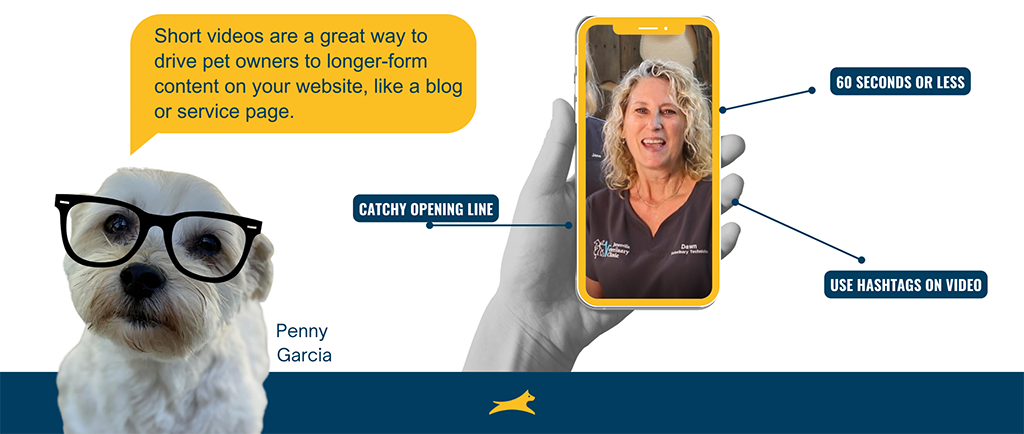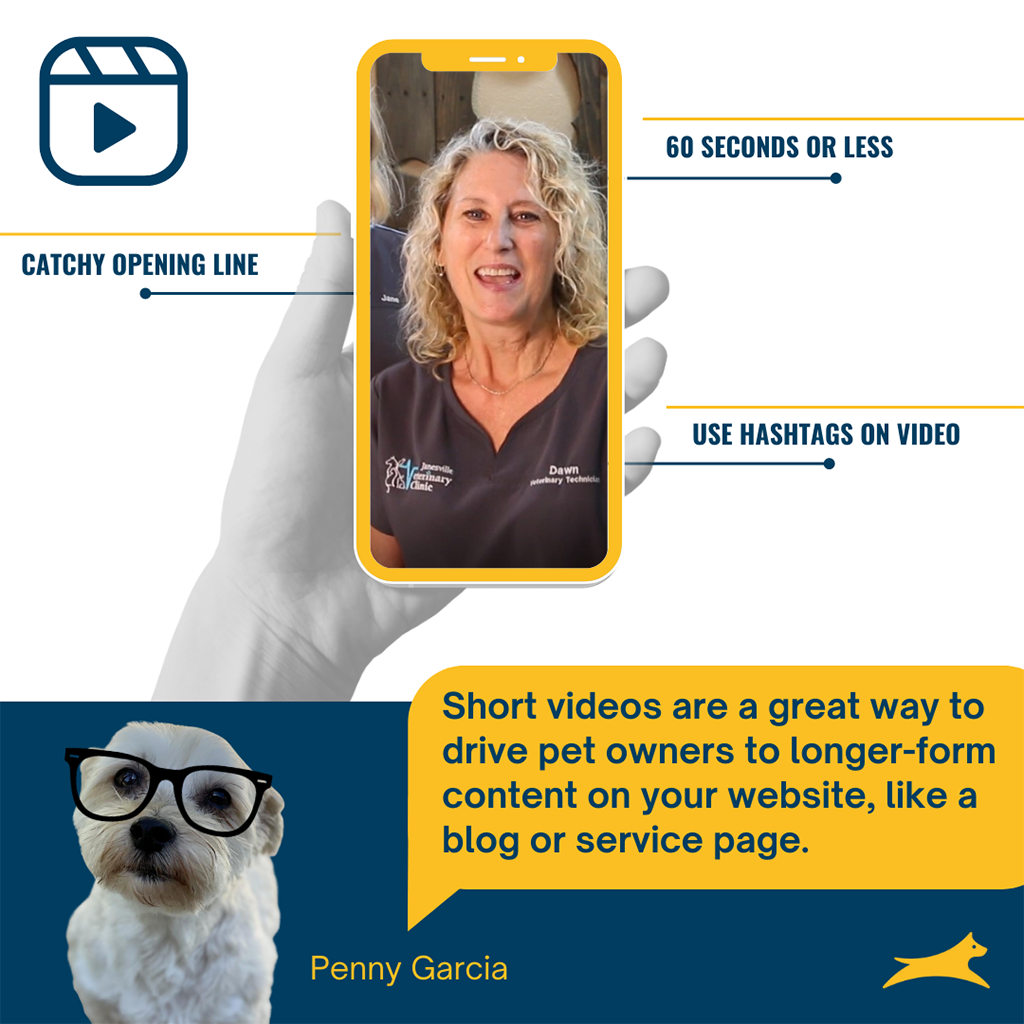Short-Form Video for the Busy Veterinary Practice


Jenny is a marketing consultant who has more than a decade of veterinary marketing experience, and she is obsessed with developing highly-engaging digital marketing solutions that are achievable for busy veterinary professionals.
You know it’s happening. The phenomenon of short-form video is here. Over 90% of viewers watch videos on IG. If you’re like most veterinary practices, you’ve buried your head in the sand, hoping the trend passes. However, short-form video marketing is here to stay, and the future marketing success of your vet practice may rely on it!
If you Google the term “video marketing”, you will be inundated with thousands of tutorials and tips. We recommend not doing that! We’re keeping it SimplyDone for you–here are the essentials:
Here’s the Good News
Video casts a wider net than other forms of marketing, which means you’ll reach more pet owners. Videos that are less than 60 seconds retain 80% of viewers through their halfway marks, and a full 60% all the way to the end. These are great retention rates, on social platforms where pet owners are constantly bombarded and distracted.
Although it’s overwhelming at first, once you get started, you’ll quickly get the hang of it. In fact, you may even realize before long that short-form video can actually be easier in terms of content creation since you can get multiple pieces of content from just one video.
Short videos are also a great way to drive pet owners to longer-form content on your website, like a blog or service page.
Ready to try one?
Let’s Start with a Reel
Reels are 90-second or less videos that are posted on Instagram and/or Facebook.
They’re great because they have long-lasting value, as they are stored permanently on your feed and grid. Reels can also be broken down into several “stories” (60 seconds or less) so you can get more content from just one video. (Stories are a vertical, temporary form of content that last only 24 hours.)
Eight Steps to the Perfect Veterinary Reel
1. Choose your message:
What is the one kernel every pet owner who watches your video will walk away with? Think about the most common concerns pet owners always ask question about” and brainstorm with your team on these topics.
An example might be: “Senior Pets”
2. Now it’s time to break it down:
Think about the topic you want to talk about, and try to summarize in one sentence what it is and how it helps patients.
Example: “Senior pets still need routine vet care to extend and maintain the quality of their lives.”
3. Map out the beginning, middle, and end of your video:
No fancy storyboard needed. Just grab a piece of scrap paper!
Beginning – Don’t fill this time with an introduction of who you are – you only have 3 seconds to hook pet owners into watching your video. So instead, use a catchy opening line that identifies the problem or creates curiosity. The key is to make it relatable – you want the pet owner to read the headline and think, “Yeah! My pet is like that!” Here are some examples:
- Is your dog itchy?
- Is your senior pup struggling to get up and down stairs?
- Is your cat less interested in playing?
Middle – Problem & Solution
Problem: Pets mask their pain – conditions can be caught earlier
Solution: Senior Bloodwork Panel during your senior pet’s routine exam helps us:
- Monitor white & red blood cell counts (and establish a baseline)
- Assess your pet’s kidney, liver, pancreas & thyroid functioning
End – Benefit & CTA
You want your short video to end with a clear benefit, followed by an opportunity to take action (CTA)
- Together, we can keep your pet feeling as comfortable and active as possible in their golden years, with routine wellness checks. (benefit)
- For some ideas on ways you can help your senior pet at home, check out our recent blog. (CTA)
4. Prepare to Shoot:
- Keep your phone vertical
- Make sure you’re using 1080 HD on your phone’s camera settings
- Optimal video length: 60 seconds or less
- Make sure you clean your phone’s camera lens in case it has fingerprint smudges on it–it sounds so simple, but… we’ve learned the hard way.
5. Shooting your Veterinary Reel:
- Create the raw content outside of the Facebook or Instagram app; this way you have the raw content on file and can repurpose the video in the future for stories, remixes, etc.
- If you’re shooting yourself, use the camera on the back of your phone; the front camera’s quality is not as good on most phones.
- As you shoot, make sure the main source of light in the room is not behind the subject you’re filming and that there isn’t a lot of background noise
- Remember, you want a BIG impact in the first 3 seconds, so make sure the energy is high and be creative!
6. Editing your Veterinary Video:
- You can edit your video in Canva, or by using your native phone editor,
- Once you have the video the way you want it, upload it to Instagram. If your account is linked to Facebook, you can automatically publish it to both platforms at the same time.
- Add text (like captions or text overlays), or music. The platform officially recommends adding these elements in the app for searchability; this means your video will get seen more AND it will help Instagram deliver your content to the right audience (pet owners)
- Remember to have fun with editing so the end result is something entertaining versus just “salesy” or self-serving — this will help ensure that pet owners keep watching.
7. Schedule:
- Instagram is rolling out the ability to schedule reels directly in the app, which can help you plan out almost all of your feed content. To use this feature, create a reel and tap Advanced Settings before publishing. Then tap to adjust the timing and schedule the Reel. If you don’t yet have the in-app scheduling feature, you can schedule Instagram video content using Meta’s desktop tools instead.
- If you aren’t scheduling ahead and you’ve already saved a draft, then you can quickly add stickers to stories or audio and covers to reels before sharing the content to Instagram. Or if you’ve created all of the separate elements—including the caption, text elements, and short-form video—you can piece together and publish reels and stories much more efficiently.
- Add hashtags related to cat and dog owners in your area, like “#TampaDogs or #TampaCats
Include keywords in the caption itself to improve your chance of delivering content to the right audience. “Senior Dogs and Cats” would be a good phrase to include from the example we used above.
8. After you post your reel:
After you post your reel, it will live on a separate Reels tab on your Instagram and Facebook profiles. From there, you can share it to your feed so it also appears on your main profile grid and to your newsfeed on Facebook.
In Summary
Start easy, pick one topic, and practice a few times. The more you do, the easier it will become. Over time, pet owners in your community will want to follow you so they don’t miss out on your fun and educational videos. Before you know it, you’ll be creating reels like a ninja, and your online presence will be more relevant than ever!
For inspiration, here are a couple of our clients who are having fun with reels:
- https://www.instagram.com/carletonveterinaryservices/reels/
- https://www.instagram.com/oakforestvet/reels/
- https://www.instagram.com/templeterraceanimalhospital/reels/
Dive in, and tag us in your very first reel so we can celebrate with you. After all, you’ve emBARKed on the future of veterinary marketing–sharing YOU in the most relatable, authentic way possible.
Short-Form Video for the Busy Veterinary Practice

You know it’s happening. The phenomenon of short-form video is here. Over 90% of viewers watch videos on IG. If you’re like most veterinary practices, you’ve buried your head in the sand, hoping the trend passes. However, short-form video marketing is here to stay, and the future marketing success of your vet practice may rely on it!
If you Google the term “video marketing”, you will be inundated with thousands of tutorials and tips. We recommend not doing that! We’re keeping it SimplyDone for you–here are the essentials:
Here’s the Good News
Video casts a wider net than other forms of marketing, which means you’ll reach more pet owners. Videos that are less than 60 seconds retain 80% of viewers through their halfway marks, and a full 60% all the way to the end. These are great retention rates, on social platforms where pet owners are constantly bombarded and distracted.
Although it’s overwhelming at first, once you get started, you’ll quickly get the hang of it. In fact, you may even realize before long that short-form video can actually be easier in terms of content creation since you can get multiple pieces of content from just one video.
Short videos are also a great way to drive pet owners to longer-form content on your website, like a blog or service page.
Ready to try one?
Let’s Start with a Reel
Reels are 90-second or less videos that are posted on Instagram and/or Facebook.
They’re great because they have long-lasting value, as they are stored permanently on your feed and grid. Reels can also be broken down into several “stories” (60 seconds or less) so you can get more content from just one video. (Stories are a vertical, temporary form of content that last only 24 hours.)
Eight Steps to the Perfect Veterinary Reel
1. Choose your message:
What is the one kernel every pet owner who watches your video will walk away with? Think about the most common concerns pet owners always ask question about” and brainstorm with your team on these topics.
An example might be: “Senior Pets”
2. Now it’s time to break it down:
Think about the topic you want to talk about, and try to summarize in one sentence what it is and how it helps patients.
Example: “Senior pets still need routine vet care to extend and maintain the quality of their lives.”
3. Map out the beginning, middle, and end of your video:
No fancy storyboard needed. Just grab a piece of scrap paper!
Beginning – Don’t fill this time with an introduction of who you are – you only have 3 seconds to hook pet owners into watching your video. So instead, use a catchy opening line that identifies the problem or creates curiosity. The key is to make it relatable – you want the pet owner to read the headline and think, “Yeah! My pet is like that!” Here are some examples:
- Is your dog itchy?
- Is your senior pup struggling to get up and down stairs?
- Is your cat less interested in playing?
Middle – Problem & Solution
Problem: Pets mask their pain – conditions can be caught earlier
Solution: Senior Bloodwork Panel during your senior pet’s routine exam helps us:
- Monitor white & red blood cell counts (and establish a baseline)
- Assess your pet’s kidney, liver, pancreas & thyroid functioning
End – Benefit & CTA
You want your short video to end with a clear benefit, followed by an opportunity to take action (CTA)
- Together, we can keep your pet feeling as comfortable and active as possible in their golden years, with routine wellness checks. (benefit)
- For some ideas on ways you can help your senior pet at home, check out our recent blog. (CTA)
4. Prepare to Shoot:
- Keep your phone vertical
- Make sure you’re using 1080 HD on your phone’s camera settings
- Optimal video length: 60 seconds or less
- Make sure you clean your phone’s camera lens in case it has fingerprint smudges on it–it sounds so simple, but… we’ve learned the hard way.
5. Shooting your Veterinary Reel:
- Create the raw content outside of the Facebook or Instagram app; this way you have the raw content on file and can repurpose the video in the future for stories, remixes, etc.
- If you’re shooting yourself, use the camera on the back of your phone; the front camera’s quality is not as good on most phones.
- As you shoot, make sure the main source of light in the room is not behind the subject you’re filming and that there isn’t a lot of background noise
- Remember, you want a BIG impact in the first 3 seconds, so make sure the energy is high and be creative!
6. Editing your Veterinary Video:
- You can edit your video in Canva, or by using your native phone editor,
- Once you have the video the way you want it, upload it to Instagram. If your account is linked to Facebook, you can automatically publish it to both platforms at the same time.
- Add text (like captions or text overlays), or music. The platform officially recommends adding these elements in the app for searchability; this means your video will get seen more AND it will help Instagram deliver your content to the right audience (pet owners)
- Remember to have fun with editing so the end result is something entertaining versus just “salesy” or self-serving — this will help ensure that pet owners keep watching.
7. Schedule:
- Instagram is rolling out the ability to schedule reels directly in the app, which can help you plan out almost all of your feed content. To use this feature, create a reel and tap Advanced Settings before publishing. Then tap to adjust the timing and schedule the Reel. If you don’t yet have the in-app scheduling feature, you can schedule Instagram video content using Meta’s desktop tools instead.
- If you aren’t scheduling ahead and you’ve already saved a draft, then you can quickly add stickers to stories or audio and covers to reels before sharing the content to Instagram. Or if you’ve created all of the separate elements—including the caption, text elements, and short-form video—you can piece together and publish reels and stories much more efficiently.
- Add hashtags related to cat and dog owners in your area, like “#TampaDogs or #TampaCats
Include keywords in the caption itself to improve your chance of delivering content to the right audience. “Senior Dogs and Cats” would be a good phrase to include from the example we used above.
8. After you post your reel:
After you post your reel, it will live on a separate Reels tab on your Instagram and Facebook profiles. From there, you can share it to your feed so it also appears on your main profile grid and to your newsfeed on Facebook.
In Summary
Start easy, pick one topic, and practice a few times. The more you do, the easier it will become. Over time, pet owners in your community will want to follow you so they don’t miss out on your fun and educational videos. Before you know it, you’ll be creating reels like a ninja, and your online presence will be more relevant than ever!
For inspiration, here are a couple of our clients who are having fun with reels:
- https://www.instagram.com/carletonveterinaryservices/reels/
- https://www.instagram.com/oakforestvet/reels/
- https://www.instagram.com/templeterraceanimalhospital/reels/
Dive in, and tag us in your very first reel so we can celebrate with you. After all, you’ve emBARKed on the future of veterinary marketing–sharing YOU in the most relatable, authentic way possible.

Jenny has more than a decade of veterinary marketing experience, and she is obsessed with developing highly-engaging digital marketing solutions that are achievable for busy veterinary professionals.

